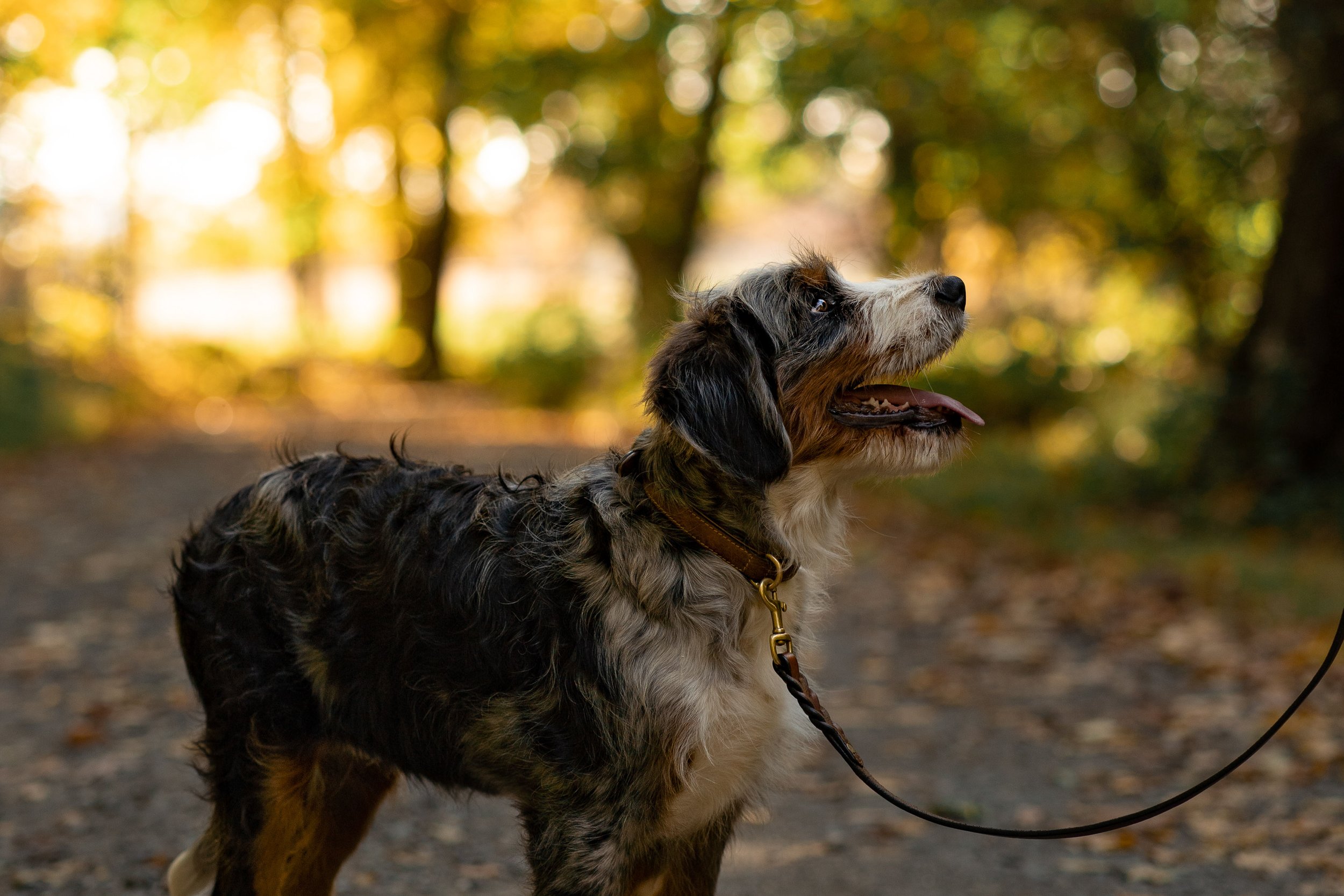
EQUIPMENT OVERVIEW
NOTE: All products have affiliate links, so I earn a small commission on each purchase. Happy training!
A flat collar that doesn’t constrict is usually the best choice, but for breeds with a head and neck of similar size, like greyhounds, a martingale collar might be a better option. It’s also smart to keep a flat collar with tags on your puppy at all times—just in case they make a great escape, they’ll have some ID on them.
A 4-6ft leash of any material will do the job, but if you want to keep your hands happy, leather is the way to go. As for retractable leashes? They’re a no-go—seriously, they’re super dangerous for both you and your dog. Skip those and stick to the safer options.
A 15-20ft long line is an awesome tool for practicing recall and teaching your dog to walk on a leash. Just avoid going longer—it can quickly turn into a tangled mess that's tough to handle.
A treat pouch is basically a mini bag that hangs on your waist, kind of like a fanny pack, and holds a stash of treats for training sessions. It’s not a must-have, but it sure makes juggling the leash and treats a lot easier during training.
A clicker is basically your dog's way of knowing they've nailed it and are about to score a treat. But let’s be real—your dog won’t just get this right off the bat, so you’ll have to teach them. If the idea of juggling one more gadget feels like overkill, just use a verbal “yes” to get the point across instead. Same deal, less gear.
SELECTING THE RIGHT TREATS
-
The most important thing about a training treat? Your dog’s gotta love it. If they’re not really into the treat, good luck motivating them during training. This means that using your dog’s kibble or bits of fruits and veggies might not cut it, especially when you’re training outside in more distracting environments.
Just like us, dogs can get bored of the same thing over and over. Your dog might be head over heels for a particular treat, but if that’s all they get, they might lose interest as the session goes on. Keep a variety of treats on hand and mix them up throughout the session to keep your dog excited and motivated.
To keep your dog extra focused on those treats, consider holding off on feeding them until after the training session. And if you end up dishing out a lot of treats, you might want to scale back their next meal a bit so they don’t overdo it.
-
A good rule of thumb for picking training treats? Go for ones that are soft, smelly, and easy to break apart. I’m a fan of semi-moist treats—they’ve got that strong scent that drives dogs wild. The most popular example of this would be “Pupperoni.” While it’s not the healthiest option and can sometimes upset a dog’s stomach, it’s almost guaranteed to be a hit. Just remember, moderation is key!
Semi-moist treats are great because they’re easy to break into small pieces, which is key for training. You don’t want to fill your dog up too quickly, so keep those treat sizes tiny—the biggest pieces should be no larger than a pea, even for big dogs. For smaller breeds, I often just break off a little taste with my fingernail.
As for hard biscuits? Not so much. They’re tough to break into small pieces, which means you’ll end up giving treats that are way bigger than necessary. Plus, they’re super crumbly, which can turn your training session into a crumb-licking mission for your dog. Not ideal!
-
For picky dogs or when training in highly distracting environments, you might need to up your treat game with something even more irresistible than the usual semi-moist options. Any treat your dog considers extra yummy is called a “high-value” treat. You might already have some in your fridge, like string cheese or hot dogs.
If you’re looking for something less perishable or if your dog has a sensitive stomach, try freeze-dried dog treats. These typically have limited ingredients, which can be gentler on your dog’s tummy compared to semi-moist treats or hot dogs. While freeze-dried treats can be a bit harder to break apart, they’re usually so beloved by dogs that they’re worth the extra effort.
PUP-PERONI
These sticks are so handy and they are universally liked by the canine community. They are a bit rich, so not a great choice for sensitive stomachs.
BEEF LIVER
Ingredients? One ingredient: beef liver. If you have a dog with a sensitive stomach or allergies, this is a great option.
PBNANAS
Bil-Jac makes a variety of amazing treats (the dogs agree) and these are no different. Great for dogs that love peanut butter!
LITTLE-JACS
These Little-Jacs are semi-moist liver treats that are easy to break. They are a reliable favorite amongst dogs I have worked with.
DUCK TREATS
Bocce’s Bakery Training Bites are quite small, but suitable for any sized dog. Generally these do not need to be broken into smaller pieces.
PB TREATS
Bocce’s Bakery Training Bites are quite small, but suitable for any sized dog. Generally these do not need to be broken into smaller pieces.
BEEF TREATS
Bocce’s Bakery Training Bites are quite small, but suitable for any sized dog. Generally these do not need to be broken into smaller pieces.
CHICKET TREATS
Bocce’s Bakery Training Bites are quite small, but suitable for any sized dog. Generally these do not need to be broken into smaller pieces.













